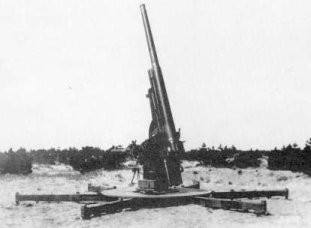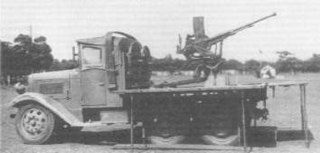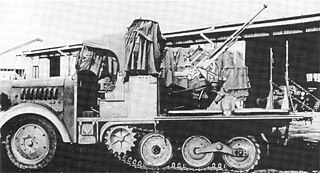
The Type 97 Light armored car Te-Ke was a tankette used by the Imperial Japanese Army in the Second Sino-Japanese War, at Nomonhan against the Soviet Union, and in World War II. It was designed as a fast reconnaissance vehicle, and was a replacement for the earlier Type 94 tankette.

The Type 98 20 mm AA machine cannon was the most common light anti-aircraft gun of the Imperial Japanese Army. It entered service in 1938 and was used until the end of World War II. After World War II this gun was used by the Indonesian Army in the Indonesian National Revolution and North Vietnam in First Indochina War.

The Type 11 75 mm anti-aircraft gun was an anti-aircraft gun used by the Imperial Japanese Army after World War I. The Type 11 designation was given to this gun as it was accepted in the 11th year of Emperor Taishō's reign (1922). It was the first anti-aircraft gun in Japanese service, but only a small number were produced, and it was superseded by the Type 14 10 cm gun and the Type 88 75 mm gun in active service before the start of World War II.

The Type 88 75 mm AA gun was an anti-aircraft gun used by the Imperial Japanese Army during the Second Sino-Japanese War and World War II. The Type 88 number was designated for the year the gun was accepted, 2588 in the Japanese imperial year calendar, or 1928 in the Gregorian calendar. It replaced the earlier Type 11 75 mm AA gun in front line combat service, and at the time was equal in performances to any of its contemporaries in western armies and was considered capable of handling any targets the Japanese army was likely to encounter on the Asian mainland. Although it was soon overtaken by improvements in aircraft technology and was largely obsolete by 1941, it continued to be used on many fronts until the end of the war.

The Type 4 75 mm AA gun was an anti-aircraft gun developed by the Imperial Japanese Army. They started producing the gun in 1943. The Type 4 number was designated for the year the gun was accepted, 2604 in the Japanese imperial year calendar, or 1944 in the Gregorian calendar. Due to the lack of raw materials available and the great damage by air raids to its industrial infrastructure, only 70 units were made. These units were retained for defense of the Japanese home islands during World War II.

The Type 99 88 mm AA gun was an anti-aircraft gun used by the Imperial Japanese Army during World War II. The Type 99's number was designated for the year the gun was accepted, 2599 in the Japanese imperial year calendar.

The Type 14 10 cm AA gun was an anti-aircraft gun used by the Imperial Japanese Army after World War I. The Type 14 number was designated for the year the gun was accepted, the 14th year of Emperor Taishō's reign, 1929 in the Gregorian calendar. Only a small number were produced, and it was superseded by the Type 88 75 mm AA gun in production before the start of World War II.

The Type 3 12 cm AA gun was an anti-aircraft gun used in quantity by the Imperial Japanese Army during World War II.The Type 3 number was designated for the year the gun was accepted, 2603 in the Japanese imperial year calendar, or 1943 in the Gregorian calendar. It replaced the earlier Type 88 75 mm AA Gun in Japanese service.

The Type 5 15 cm anti-aircraft gun was a large caliber anti-aircraft gun developed by the Imperial Japanese Army during the final days of World War II. The Type 5 number was designated for the year the gun was accepted, 2605 in the Japanese imperial year calendar, or 1945 in the Gregorian calendar. It was intended to replace the earlier Type 3 12 cm AA Gun as a defense against American air raids on Japan.

The AA machine cannon carrier truck was a self-propelled anti-aircraft gun of the Imperial Japanese Army. It consisted of the Type 98 20 mm AA machine cannon mounted on the back of a Type 94 six-wheeled truck. The Type 94 truck was first produced in 1934 by Isuzu, and used for prototypes. It was known to be reliable and was produced in "large numbers".

The Type 98 20 mm AAG tank was a Japanese self-propelled anti-aircraft gun using a twin Soki Type 2 20 mm anti-air gun. It utilized the chassis of the Type 98 Ke-Ni light tank.

The Type 96 25 mm gun was an automatic cannon used by the Imperial Japanese Navy during World War II. A locally-built variant of the French Hotchkiss 25 mm anti-aircraft gun, it was designed as a dual-purpose weapon for use against armored vehicles and aircraft, but was primarily used as an anti-aircraft gun in fixed mounts with one to three guns.

The Type 98 20 mm AA half-track vehicle was an experimental Japanese self-propelled anti-aircraft gun. It had a single 20 mm Type 98 AA cannon mounted on the back section of a Type 98 Ko-Hi half-tracked prime mover. The Type 98 Ko-Hi half-track was first manufactured in 1938.

The Type 92 heavy armoured car, also known as the Type 92 cavalry tank, was the Empire of Japan's first indigenous tankette. Designed for use by the cavalry of the Imperial Japanese Army by Ishikawajima Motorcar Manufacturing Company, the Type 92 was designed for scouting and infantry support. The Type 92 was thin armored and lightly armed. Although actually a light tank, it was called sōkōsha in Japanese due to political sectionalism within the Japanese Army. Exactly the same device was used in America with the M1 Combat Car.

The Type 1 Ho-Ki was a tracked armored personnel carrier (APC) developed by the Imperial Japanese Army in World War II.

An artillery tractor, also referred to as a gun tractor, is a specialized heavy-duty form of tractor unit used to tow artillery pieces of varying weights and calibres. It may be wheeled, tracked, or half-tracked.

The experimental Type 98 Ta-Se was a Japanese self-propelled anti-aircraft gun using a Type 98 20 mm anti-aircraft gun. It used the chassis of the Type 98 Ke-Ni light tank.

The Type 98 Ko-Hi a/k/a Type 98 half-tracked prime mover "Ko-Hi" was a half-track used by the Imperial Japanese Army (IJA). Introduced in 1938, it was used during the Second Sino-Japanese War and World War II.


















